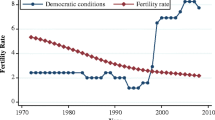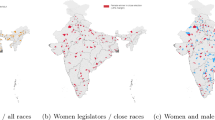Abstract
This paper empirically examines associations between female labor force participation (FLFP) and democracy. Using a cross-country, time series (1980–2005) data set, we find evidence that FLFP is lower in democracies. One possible explanation is that dictators promote FLFP above what traditional norms would dictate and so a greater freedom to follow custom lowers FLFP. However, we also find that the ratio of FLFP to male labor force participation (MLFP) is similar under both types of regimes and that MLFP is also lower in democracies. This outcome casts doubt on the aforementioned explanation. Instead, one possibility is that both men and women voluntarily withdraw from the labor force with greater freedoms.
Similar content being viewed by others
Notes
However, Bayanpourtehrani and Sylwester (2012) find that the negative association between Islam and FLFP greatly weakens outside the Middle East. Ross (2008) argues that the reason for the negative association between Islam and FLFP is that many Islamic countries export oil and the proceeds from oil revenue raise women’s reservation wages.
It is also possible that causality runs in the opposite direction as the ability of women to politically organize and advocate leads to democratic change as argued in Fish (2002). Eto (2008) sees Japanese women’s movements as a key contributor to democracy in postwar Japan. Waylen (1994) argues for a similar importance of women’s movements for democracy in Latin America. Finally, Inglehart et al. (2002) find that modernization increases the prevalence of women in government and promotes democratic change thereby producing a spurious correlation between democracy and women’s political opportunities.
Government provided daycare could be one example of an enticement.
To avoid confusion, note that FLFP used previously is shorthand for the term “female labor force participation” whereas RATE refers specifically to the dependent variable in (1), the female labor force participation rate.
We also estimated (1) using a random effects model. However, the null hypothesis that the random effects were uncorrelated with the other right hand side variables was rejected at the 2 % level for each of the four democracy measures considered in Tables 2 and 3 and rejected at the 1% level for all but one of the 16 specifications.
However, the potential endogeneity of the right hand side variables might not greatly bias coefficient estimates in this application. Nickell (1981) shows that biases from the inclusion of lagged dependent variables on the right hand side are small when the time dimension goes to infinity. Judson and Owen (1999) report that biases on these right hand side variables are less than 3 % when using more than 20 periods. We have 25 years of data for many countries although not for the former Soviet countries.
However, we do not employ system-GMM from Arellano and Bover (1995) or Blundell and Bond (1998) since an assumption of system-GMM is that differences in the endogenous variables are not correlated with the fixed effects. But if changes in FLFP or political changes are correlated with time invariant factors (which we believe is plausible) then this assumption of system-GMM is violated.
We do not employ the Polity IV measures for two reasons. First, fewer countries are represented. Two, the Freedom House measures, as stated, distinguish two aspects of democracy: political rights and civil liberties. Although correlated, the two can differ such as when a dictator allows more personal freedoms but does not offer competitive elections. Therefore, this paper focuses on the Freedom House measures.
Other concerns with the Freedom House measures is a lack of transparency in their construction and that non-political factors such as economic freedoms are also incorporated into the civil liberties index. See Munck and Verkuilen (2002) for further discussion of these and other concerns.
Specifically, DEM_PS = 1 if a country experienced a full or partial democratization episode that has been sustained to the present and = 0, otherwise. This is the variable mainly considered by Papaioannou and Siourounis (2008).
Results are robust to removing countries that were democratic throughout 1980–2005 from the sample. After removing these countries, the control group becomes the set of countries remaining nondemocratic. In Tables 2 and 3, the control group comprises the countries not undergoing a democratic transition between 1980 and 2005 either because they were already democratic or because they remained nondemocratic. Therefore, results are robust across these two different control groups.
Without the interaction term, associations between the FLFP rate and the democracy variables are even stronger. Results are also robust to removing the former Communist countries from the sample.
We do not calculate beta coefficients for three reasons. First, DEM_PS is a dummy and PR and CL only take on integer values. Thus, no country experienced a one standard deviation change in these measures. Second, the democracy changes considered in MAG are the largest ones possible and, yet, the predicted effects on RATE are still small. Thus, they would remain small if one also computed beta coefficients relying on smaller changes of the democracy variables. Third, since coefficients only capture within country variation, normalizing the predicted changes by the standard deviation of the dependent variable across the entire sample would compare “apples to oranges” since both within country and cross country variation would influence the denominator. Instead, we normalize by the average within country standard deviation.
Results are also robust to adding the fraction of the population that is urban or working in agriculture as controls. Such controls could be necessary since both could be associated with political change as well as in determining female labor supply. Nevertheless, the coefficients upon the democracy variables change little whereas the coefficients on these additional controls are insignificant.
The coefficient upon CL, however, is not statistically significant.
Of course, growth could still increase if democracies use inputs more efficiently than do autocracies.
References
Amin, S., Diamond, I., Naved, R. T., & Newby, M. (1998). Transition to adulthood of female garment-factory workers in Bangladesh. Studies in Family Planning, 29(2), 185–200.
Arellano, M. (1987). Computing robust standard errors for within-groups estimators. Oxford Bulletin of Economics and Statistics, 49(4), 431–434.
Arellano, M., & Bond, S. (1991). Some tests of specification for panel data: Monte Carlo evidence and an application to employment equations. Review of Economic Studies, 58(2), 277–297.
Arellano, M., & Bover, O. (1995). Another look at the instrumental-variable estimation of error-components models. Journal of Econometrics, 68(1), 29–51.
Barro, R. J. (1996). Democracy and growth. Journal of Economic Growth, 1(1), 1–27.
Bayanpourtehrani, G., & Sylwester, K. (2012). Female labour force participation and religion: A cross-country analysis. Bulletin of Economic Research. doi:10.1111/j.1467-8586.2012.00443.x
Beer, C. (2009). Democracy and gender equality. Studies in Comparative International Development, 44(3), 212–227.
Blundell, R., & Bond, S. (1998). Initial conditions and moment restrictions in dynamic panel data models. Journal of Econometrics, 87(1), 115–143.
Clark, R., Ramsbey, T. W., & Stier Adler, E. (1991). Culture, gender, and labor force participation: A cross-national study. Gender and Society, 5(1), 47–66.
Donno, D., & Russett, B. (2004). Islam, authoritarianism and female empowerment: What are the linkages? World Politics, 56(4), 582–607.
Eto, M. (2008). Vitalizing democracy at the grassroots: A contribution of post-war women’s movements in Japan. East Asia, 25(2), 115–143.
Fish, M. S. (2002). Islam and authoritarianism. World Politics, 55(1), 4–37.
Hammond, G. (2009). Suffrage in San Juan: The test of women’s rights in Argentina. Bulletin of Latin American Research, 28(1), 1–18.
Inglehart, R., Norris, P., & Welzel, C. (2002). Gender equality and democracy. Comparative Sociology, 1(3–4), 321–345.
Judson, R., & Owen, A. (1999). Estimating dynamic panel models: A practical guide for macroeconomists. Economics Letters, 65(1), 9–15.
Kabeer, N., & Mahmud, S. (2004). Globalization, gender, and poverty: Bangladeshi women workers in export and local markets. Journal of International Development, 16(1), 93–109.
Kenny, L., & Lott, J. R. (1999). Did women’s suffrage raise the size and scope of government? Journal of Political Economy, 107(6), 1163–1198.
Lundberg, S., & Pollak, R. A. (1993). Separate spheres bargaining and the marriage market. Journal of Political Economy, 101(6), 988–1010.
Mahony, R. (1995). Kidding ourselves: Breadwinning, babies, and bargaining power. New York: Basic Books.
Marshall, S. (1984). Politics and female status in North Africa: A reconsideration of development theory. Economic Development and Cultural Change, 32(3), 499–524.
Michael, R. T. (1985). Consequences of the rise in female labor force participation rates: Questions and probes. Journal of Labor Economics, 3(1), S117–S146.
Moghadam, V. (1999). Gender and globalization: Female labor and women’s movements. Journal of World-Systems Research, 5(2), 367–388.
Munck, G. L., & Verkuilen, J. (2002). Conceptualizing and measuring democracy: Evaluating alternative indices. Comparative Political Studies, 35(1), 5–34.
Nickell, S. (1981). Biases in dynamic models with fixed effects. Econometrica, 49(6), 1417–1426.
Okeke-Ihejirika, P. E., & Franceschet, S. (2002). Democratization and state feminism: Gender politics in Africa and Latin America. Development and Change, 33(3), 439–466.
Pampel, F., & Tanaka, K. (1986). Economic development and female labor force participation: A reconsideration. Social Forces, 64(3), 599–619.
Papaioannou, E., & Siourounis, G. (2008). Democratization and growth. Economic Journal, 118(10), 1520–1551.
Przeworski, A., & Limongi, F. (1993). Political regimes and economic growth. Journal of Economic Perspectives, 7(3), 51–69.
Rodrik, D. (1999). Democracies pay higher wages. Quarterly Journal of Economics, 114(1), 707–738.
Ross, M. L. (2008). Oil, Islam, and women. American Political Science Review, 102(1), 107–123.
Spierings, N., Smits, J., & Verloo, M. (2009). On the compatibility of Islam and gender equality, effects of modernization, state Islamization, and democracy on women’s labor market participation in 45 Muslim countries. Social Indicators Research, 90(3), 503–522.
Tavares, J., & Wacziarg, R. (2001). How democracy affects growth. European Economic Review, 45(8), 1341–1378.
Tzannatos, Z. (1999). Women and labor market changes in the global economy: Growth helps, inequalities hurt, and public policy matters. World Development, 27(3), 551–569.
Vardanian, R. A., Kochkina, E. V., & Shenfield, S. (2008). Elections: The gender gap. Russian Social Science Review, 49(3), 46–69.
Waylen, G. (1994). Women and democratization: Conceptualizing gender relations in transition politics. World Politics, 46(3), 327–354.
Acknowledgments
We would like to thank the referees for helpful suggestions that improved the paper. All errors, however, are attributable to the authors.
Author information
Authors and Affiliations
Corresponding author
Rights and permissions
About this article
Cite this article
Bayanpourtehrani, G., Sylwester, K. Democracy and Female Labor Force Participation: An Empirical Examination. Soc Indic Res 112, 749–762 (2013). https://doi.org/10.1007/s11205-012-0080-2
Accepted:
Published:
Issue Date:
DOI: https://doi.org/10.1007/s11205-012-0080-2




